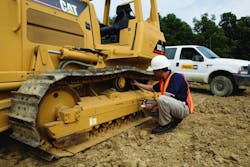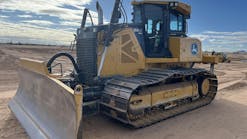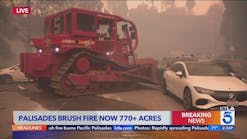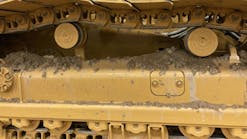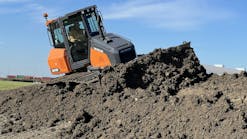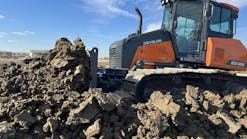Reprinted with the permission of Equipment Manager magazine, the magazine of AEMP.
Several oversights in maintenance and operation will result in excessive wear on undercarriage parts. And because the undercarriage can be responsible for up to 50 percent of a machine’s maintenance costs, it’s all the more important to properly maintain and operate crawler machines. By adhering to the following recommendations, you’ll get more life from an undercarriage and significantly reduce maintenance costs:
Track Tension
Operate the machine for at least a half hour to allow the track to acclimate to the working area before you check and set the track tension. If conditions change, like additional rainfall, readjust the tension. Tension should always be adjusted in the working area. Loose tension causes whipping at higher speeds, resulting in excessive bushing and sprocket wear. If the track is too tight, it causes stress on the undercarriage and drive train components while wasting horsepower.
Shoe Width
Equip the machine to handle the condition of the specific environment, using the narrowest shoe possible that still provides adequate flotation and function.
- A shoe that is too narrow will cause the machine to sink. During turns, the back end of the machine slides, causing excess material to build up on top of the shoe surface which then falls into the link-roller system as the machine continues to move. Tightly packed material built up on the roller frame may cause reduced link life due to the link sliding across the packed material, which may also cause the carrier roller to stop turning; and
- A slightly wider shoe will give better flotation and accumulate less material because the material is farther away from the link-roller system. If you choose shoes that are too wide, they may bend and crack more easily; cause increased wear on all components; may cause premature dry joints; and may loosen shoe hardware. A 2-inch increase in shoe width results in a 20 percent increase in bushing stress.
- See related recommendations under the debris section.
Machine Balance
Improper balance can cause an operator to believe wider shoes are necessary; accelerate undercarriage wear, thus shortening life; cause an inability to fine doze; and create an uncomfortable ride for the operator.
- A properly balanced machine will provide even track roller wear from front to rear and minimize track link rail scalloping. Good balance also will optimize track flotation and reduce the amount of track slippage; and
- Always balance a machine on a smooth, level surface and set balance with the attachment that will be on the machine.
Operator Practices
Even the best operators will struggle to notice track slippage until it is near 10 percent. That can cause decreased productivity and increased wear rates, especially on grouser bars. Decrease the load to avoid track spinning.
- Undercarriage wear is best measured in travel miles, not operating hours. Newer track-type machines measure travel by miles or kilometers in both forward and reverse;
- Consistently turning in the same direction results in unbalanced wear with more travel miles on the outside track. Alternate turning directions when possible to keep track wear rates the same. If alternate turns are not possible, check the undercarriage more often for unusual wear;
- Minimize nonproductive high operating speeds to reduce wear on undercarriage components;
- Avoid unnecessary operation in reverse to reduce sprocket and bushing wear. Reverse operation causes more bushing wear regardless of speed. The use of adjustable blades will limit the time spent in reverse because you can turn the machine and tilt the blade the other direction; and
- Operators should begin every shift with a walkaround. This visual inspection should include a check for loose hardware, leaky seals, dry joints and abnormal wear patterns.
Application
The following conditions are applicable only if the machine is working on a level surface:
- Dozing shifts the weight of the machine forward, causing faster wear on the front idlers and rollers;
- Ripping shifts machine weight rearward, which increases rear roller, idler and sprocket wear;
- Loading shifts weight from the rear to the front of the machine, causing more wear on the front and rear components than on the center components; and
- A qualified person should regularly measure, monitor and predict undercarriage wear to better identify repair needs early and get the most life and lowest cost per hour from an undercarriage. When checking track tension, always coast the machine to a stop rather than braking.
Terrain
When not working on level surfaces, you should follow these recommendations:
- Working uphill causes higher wear on rear undercarriage components. Allow Mother Nature to help you by working downhill because tracks last longer working downhill;
- Working on hillsides increases wear on the undercarriage parts that are on the downhill side of the machine but does cause excessive wear on guiding systems on both sides of the machine. Alternate sides when working on hills, or rotate the tracks from side to side when working on one side more than the other;
- Excessive crown work causes more wear on the inner components of an undercarriage so check the inside track wear often; and
- Excessive vee ditching (working in depressions) causes increased wear on an undercarriage’s outer components, so check often for outside track wear.
Debris
Material packed between mating components can cause incorrect engaging of parts, which will lead to increased wear rates:
- Clean debris from the undercarriage when needed during operation so rollers will turn freely, and always clean out debris at the end of a shift. This is particularly important in landfills, wet conditions or any application where material can become packed and/or frozen. Roller guards may trap debris and increase the effects of packing;
- Use center punched shoes if the material is extrudable, but don’t use them if the material has mud-like consistency; and
- Maintain the proper level of guiding because over-guiding will keep debris in the undercarriage and an under-guided machine will be more likely to have dry joints.
Excavators
There are three specific recommendations for digging with excavators:
- The preferred digging method is over the front idlers to reduce the potential for structural problems;
- Dig over the side of the excavator only when absolutely necessary; and
- Never dig over the final drive.
--Tim Nenne handles undercarriage customer and dealer support for Caterpillar.
